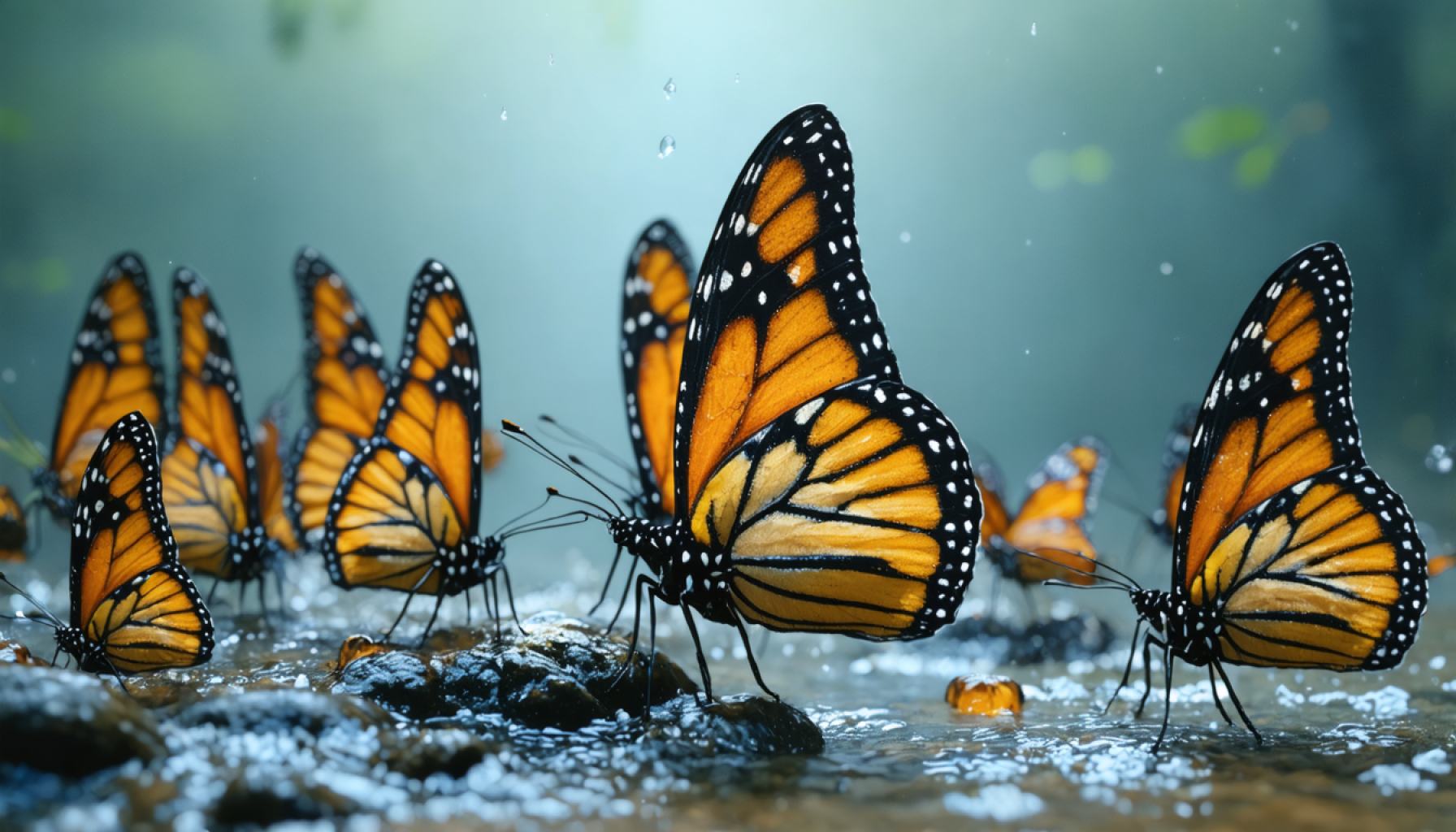- Monarch butterflies undertake an incredible migration from North America to central Mexico, showcasing nature’s resilience.
- This journey spans thousands of miles and is completed over multiple generations of monarchs, led by innate navigational abilities.
- The monarchs rely on Earth’s magnetic fields and the sun’s position to guide them across challenging landscapes.
- Reaching the oyamel fir forests, monarchs gather in spectacular colonies, crucial for their reproduction and survival.
- This migration faces threats from climate change, deforestation, and habitat loss, urging environmental protection efforts.
- The monarch’s journey symbolizes tenacity and interconnectedness, highlighting the importance of preserving nature’s wonders.
A mesmerizing ballet unfolds as millions of monarch butterflies take to the skies each year. These vibrant creatures, with their delicate wings painted in shades of orange and black, embark on one of nature’s most astonishing migrations, spanning thousands of miles from North America to the forests of central Mexico.
The journey of the monarch butterfly is a remarkable testament to nature’s resilience and adaptability. With precision and purpose, they navigate a path that no single butterfly completes. Over multiple generations, these fragile insects traverse a perilous route characterized by inclement weather and vast bodies of water. The sight of a monarch fluttering gracefully through a blue sky is a symbol of tenacity and transformation.
Guided by an inherent compass that aligns with the Earth’s magnetic fields and the position of the sun, monarchs cover distances up to 3,000 miles. Their wings tirelessly beat against the wind, a vivid reminder of the innate drive shared among living creatures—to survive and thrive.
Upon reaching the iridescent oyamel fir forests, thick with the fragrance of pine and damp earth, the monarchs cluster in massive colonies. These gatherings create an otherworldly tapestry of flickering color as sunlight filters through the canopy, turning the entire scene into a living kaleidoscope. It is here these butterflies find sanctuary and reproduce, ensuring the survival of future generations.
But this remarkable migration is under threat. Climate change, deforestation, and habitat loss pose grave dangers to the monarchs’ survival. Environmentalists advocate for preserving the butterfly’s habitat and migratory pathways, emphasizing that their journey is not just an ecological marvel but a crucial indicator of our planet’s health.
The monarch butterfly’s odyssey imparts a powerful message: small beings can achieve extraordinary feats. Their journey is a poignant reminder of the interconnectedness of all life on Earth. By safeguarding their fragile realms, we celebrate the vitality of our natural world, ensuring future generations can witness this breathtaking parade of perseverance and beauty.
Astonishing Monarch Migration: Secrets You Didn’t Know
Inside the Epic Journey of Monarch Butterflies
The majestic migration of monarch butterflies from North America to the forests of central Mexico is not only a spectacle of nature but also a testament to the resilience and adaptability of these creatures. While the surface story is well-known, there are numerous fascinating details and considerations that were not fully explored in depth.
How Monarchs Navigate Their Epic Journey
Monarchs utilize an internal compass driven by a combination of the Earth’s magnetic fields and the sun’s position. This natural navigation system is incredibly precise, allowing them to cover up to 3,000 miles despite never having made the journey before. Researchers have discovered that monarchs use a circadian clock in their antennae to help with navigation, which adjusts for the sun’s movement across the sky (Source: National Geographic).
Real-World Impact and Environmental Concerns
Monarch butterflies’ migration is threatened by climate change, deforestation, and habitat loss. These factors disrupt their breeding and migratory habitats. According to studies, the loss of milkweed plants, which are essential for monarch larvae, has significantly impacted monarch populations (Source: WWF).
How to Help Protect Monarch Butterflies
– Plant Milkweed: Support monarch populations by planting milkweed, especially native species, in gardens and communities. This provides essential breeding habitat.
– Reduce Pesticide Use: Limit the use of pesticides, which can harm monarchs at various life stages.
– Support Conservation Efforts: Contribute to organizations dedicated to preserving monarch habitats and advocating for environmental policies.
Industry Trends and Insights
Environmental and conservation organizations are increasingly leveraging technology and citizen science to track monarch populations and migration patterns. Apps and interactive maps allow individuals to report sightings, which scientists use to better understand migration trends.
Reviews and Comparisons
Comparing the monarch migration to other animal migrations provides context to its scale. While animal migrations like the wildebeest in Africa or the Arctic tern’s pole-to-pole trek are impressive, the monarch’s journey is unique due to the multiple generations involved in completing a single migration cycle.
Current Challenges and Future Predictions
– Controversies: The impact of genetically modified crops on the availability of milkweed is debated among scientists and environmentalists.
– Predictions: If current trends continue without intervention, monarch populations could face severe declines. However, hopeful developments in habitat restoration and conservation policy could stabilize or even enhance their numbers.
Quick Tips for Immediate Action
1. Engage in Citizen Science: Participate in monarch tagging programs or report local sightings to contribute to data collection.
2. Educate Others: Raise awareness about the plight of monarchs and the simple ways communities can help.
Recommended Resources
For more information on how you can make a difference, visit World Wildlife Fund and National Geographic.
By implementing these actions and spreading awareness, we can aid in the preservation of the monarchs’ breathtaking journey. In doing so, we not only protect a vital ecological event but also honor the interconnectedness of life on Earth.
